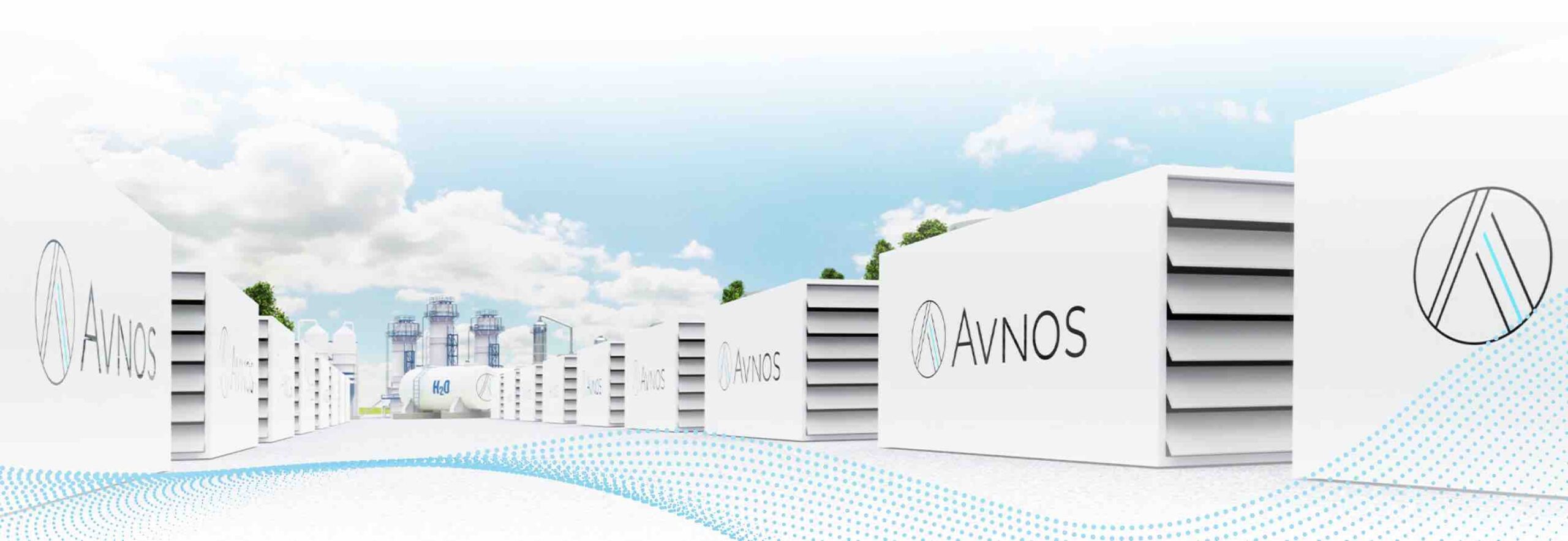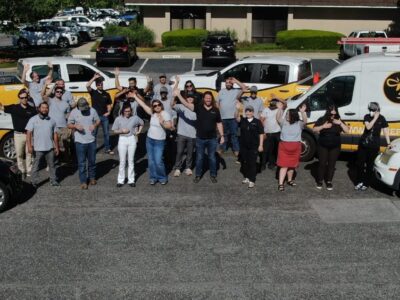(Bloomberg) —
A lightly trafficked stretch of road near Bakersfield, California, may seem an odd place to try to solve two environmental crises at once. But there, sandwiched between a decommissioned solar thermal project and an almond farm, a company is testing a machine that can suck carbon dioxide and water out of the air.
That machine is the first attempt by Avnos, a Los Angeles-based startup, to prove it can do what it calls hybrid direct air capture (DAC). Its technique would clean the air of CO2 and capture water that can be used in an era of worsening drought. It’s a moonshot bet on an already moonshot technology.
The Department of Energy recently announced it’s investing more than $1 billion into several projects aimed at capturing CO2 from the ambient air. Avnos is part of a research group that received $12 million of those funds. (The company also raised $80 million in its latest funding round.) A number of startups working on the problem use machines that pull air in using large fans that then pass it over or through a chemical solvent that separates the CO2 from the air. That CO2 is then sequestered underground, where it theoretically will stay for centuries or longer, rather than warming the planet in the atmosphere.
Avnos is attempting to do the same thing, but its technology also produces a valuable byproduct in the process: water. The firm’s machines pass ambient air through a desiccant that draws water out. Then, that dehumidified air passes through a patented adsorbent material, which catches the CO2. For every ton of CO2 captured, Avnos is able to produce about 5 to 10 tons of water, according to chief executive officer and founder Will Kain. Doing so turns the DAC equation on its head: The average DAC system consumes 5 to 10 tons of water for every ton of CO2 captured, according to Pete McGrail, a laboratory fellow at Pacific Northwest National Laboratory (PNNL) and advisor to Avnos.
“There’s actually a dirty little secret in that they [DAC systems] consume energy, of course,” said McGrail. “But those technologies also consume a lot of water as part of the process.”
DAC is energy intensive, which is one of the reasons for high costs. Scientists estimate that using DAC to remove billions of tons of carbon from the atmosphere annually — a scale science shows will be needed by midcentury to limit global warming to 1.5C — would require more energy than is currently available. Part of the reason DAC requires so much energy is because many of the chemical solvents used require high heat to separate the CO2 from the air.
Avnos’ system, first developed by McGrail and other researchers at PNNL more than four years ago, drastically lowers the amount of energy required to capture carbon from the air, he said. It does so by not relying on chemical solvents that must be heated up, instead using moisture-responsive physical solvents, which don’t have the same heat requirements to capture and release CO2. And what heat is required to drive the process is gathered from one side of the machine, which generates that heat, creating a unique “moisture-swing” process.
Other researchers are also evaluating the merits of a low-energy, moisture-swing approach to mitigate DAC’s high energy use. In an October study, a group from Northwestern University found that the technique can be an energy-efficient and cost-effective approach to carbon capture under the right conditions.
Although the approach tested in the study was different than Avnos’s technology, a moisture swing-based DAC system could be “an important component of the portfolio” when it comes to carbon dioxide removal, said Vinayak Dravid, a professor of materials science and engineering at Northwestern’s McCormick School of Engineering and a senior author on the study.
Producing water is central to Avnos’s value proposition. The startup’s system still requires some energy as well as investments to build the machines in the first place. Selling the water it produces to local municipalities or to companies that can use it to make sustainable aviation fuel will help offset those costs. Though DAC is in its very early stages, it’s already being met with local community opposition. Creating water as a co-product of carbon removal could give Avnos social license to operate, Kain said, particularly in places like California where water scarcity is a major issue.
Avnos’s process could produce water in communities that need water, Kain said, adding that getting industrial processes that consume copious amounts of water, like other DAC techniques, permitted in California is difficult.
McGrail said he conceived of a water-producing DAC system after learning about how much water traditional systems could use if deployed at scale.
Now that its pilot unit is set up, the challenge for Avnos is integrating the two subsystems within the machine as part of a delicate dance. The water capture subsystem and the CO2 subsystem each have been known to work on their own, Kain said, but haven’t operated as a unified system in the field until the startup fired up its machine at the Bakersfield site this summer.
On a hot day in August, the startup’s senior process engineer Atefeh Alijah approached the machine, which is about the size of a large truck. She flicked a few switches, tapped a few buttons on a digital screen and turned on the machine.
Immediately, it rumbled to life, sounding like a giant window air conditioning unit. Fans pulled air through the rust-colored filter on one side before passing through a second layer of filters. After running for a few minutes, Alijah shut the system off and reprogrammed it to run through the other side. A metal panel moved from one side to the other, revealing an identical system on the other side. The process began again.
After a few minutes, air emerges from the other side, and the precious CO2 and water are pumped through pipes to their final destination. At the demonstration site in Bakersfield, that’s a plastic barrel for the water, with enough water inside for a few small sips. The water that emerges from the machine is theoretically distilled, though it looks less than appealing inside an industrial barrel. (Kain joked he would still be willing to drink it.) The test site is designed to grab 30 tons of CO2 from the air and produce up to 300 tons of water annually.
Avnos releases the CO2 back into the ambient air since there’s no built-in storage on site. But at commercial scale, that CO2 will be stored in tanks and shipped to customers to sequester underground or turn into sustainable aviation fuel. Avnos wants to co-locate its units with utilization or sequestration partners, to avoid the cost of building transportation infrastructure, Kain said.
The eventual fate of the captured CO2 — who gets to buy it and what they do with it — is a major point of contention in the carbon capture community. Environmentalists argue that allowing fossil fuel companies to invest in carbon capture and buy removal credits would simply give them license to continue polluting.
But the industry could have a role to play: Kain has raised money from ConocoPhillips and the venture arm of Shell, and, in his view, the DAC industry is in its infant stage and should accept help from all quarters. He has no qualms about selling Avnos’s services to these same companies, as long as the CO2 isn’t used to dredge up more fossil fuels, a process known in the industry as enhanced oil recovery. Oil and gas companies also have the most experience with large-scale geologic sequestration, he pointed out, which could aid in the quest to store CO2.
The greenhouse gas could prove useful for other purposes. Kain is open to courting buyers in the aviation industry, providing captured CO2 to them as a feedstock to sustainable aviation fuel (SAF) and other processes. One way to do this is to combine hydrogen, made via splitting water into oxygen and hydrogen, with CO2, turning the combined product into fuel.
And potential buyers are emerging. JetBlue Ventures invested in Avnos because it sees captured carbon as an important feedstock for SAF, like the kind that fellow JetBlue Ventures portfolio company Air Company is developing.
“Air to fuel is one of the [SAF] pathways that we’re really excited about, and the feedstock for air to fuel is the captured carbon, and so we like this part of that chain,” said Amy Burr, president of JetBlue Ventures.
That use case, however, would be carbon neutral rather than negative. While having carbon neutral fuel for hard-to-decarbonize industries like aviation could be helpful in the fight to get to net zero emissions, SAF is also still very much in its infancy and dealing with its own growing pains.
When it comes to sequestration, Avnos will need to rely on a variety of partners. One of those potential partners is Southern California Gas Company, another early investor. Avnos and the utility alongside other partners received nearly $12 million from the US Department of Energy to design a hub to capture carbon and transport it in Kern County, California.
SoCalGas manages 100,000 miles (161,000 kilometers) of underground pipelines, transporting natural gas to businesses and homes around Central and Southern California. That may not always be the case, as the state transitions away from natural gas and towards more renewables, according to Yuri Freedman, a senior director of business development. “In a carbon-free future, we’ll be transporting different molecules,” which include CO2, he said.
Freedman oversees the company’s low-carbon infrastructure projects and views the investment in Avnos as an investment in the future of SoCalGas’s business. The company wants to take advantage of its existing rights of way to build new pipelines to transport CO2.
“We’re looking to use molecules in ways that we haven’t used them before,” he said. Many open questions remain when it comes to transforming carbon into a commodity, including how CO2 will be sold and moved in large volumes and over vast distances.
In the meantime, Avnos is working on constructing its next, larger operating site, capable of capturing 300 tons of CO2 and as much as 3,000 tons of water annually, which it expects to be up and running over within the next year. That project is sponsored by the US Department of Defense, which Kain said is interested in applying the technology towards developing SAF.
The startup projects that it will cost $500 to remove a ton of CO2 when its 300-ton plant comes online. But Kain expects the company to be able to grow to capture 500,000 tons of CO2 annually by 2028, with costs falling to $240 per ton before eventually reaching $100 per ton by the early 2030s, a very ambitious target for the timeframe. That cost is viewed by many in the DAC industry as a far-off holy grail at which point it would be economically viable to capture the billions of tons of carbon needed to keep the planet cool annually.
Getting to those economies of scale, however, is no guarantee. But Kain thinks it’s doable with a little help.
“Our best opportunity to deploy the technology, we think, is to build partnerships,” Kain said. “Developing those types of partnerships and having the opportunity to deploy our technology across multiple projects and across multiple partners at any given time, I think that that is critical in deploying at the speed at which we want to deploy and to come up the maturity curve.”
To contact the author of this story:
Michelle Ma in Los Angeles at mma304@bloomberg.net
© 2023 Bloomberg L.P.





